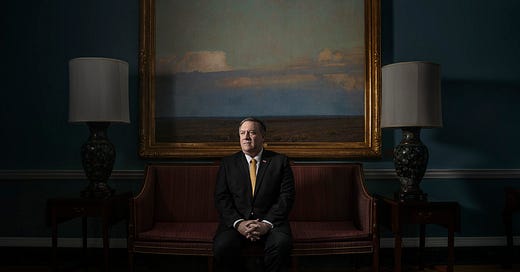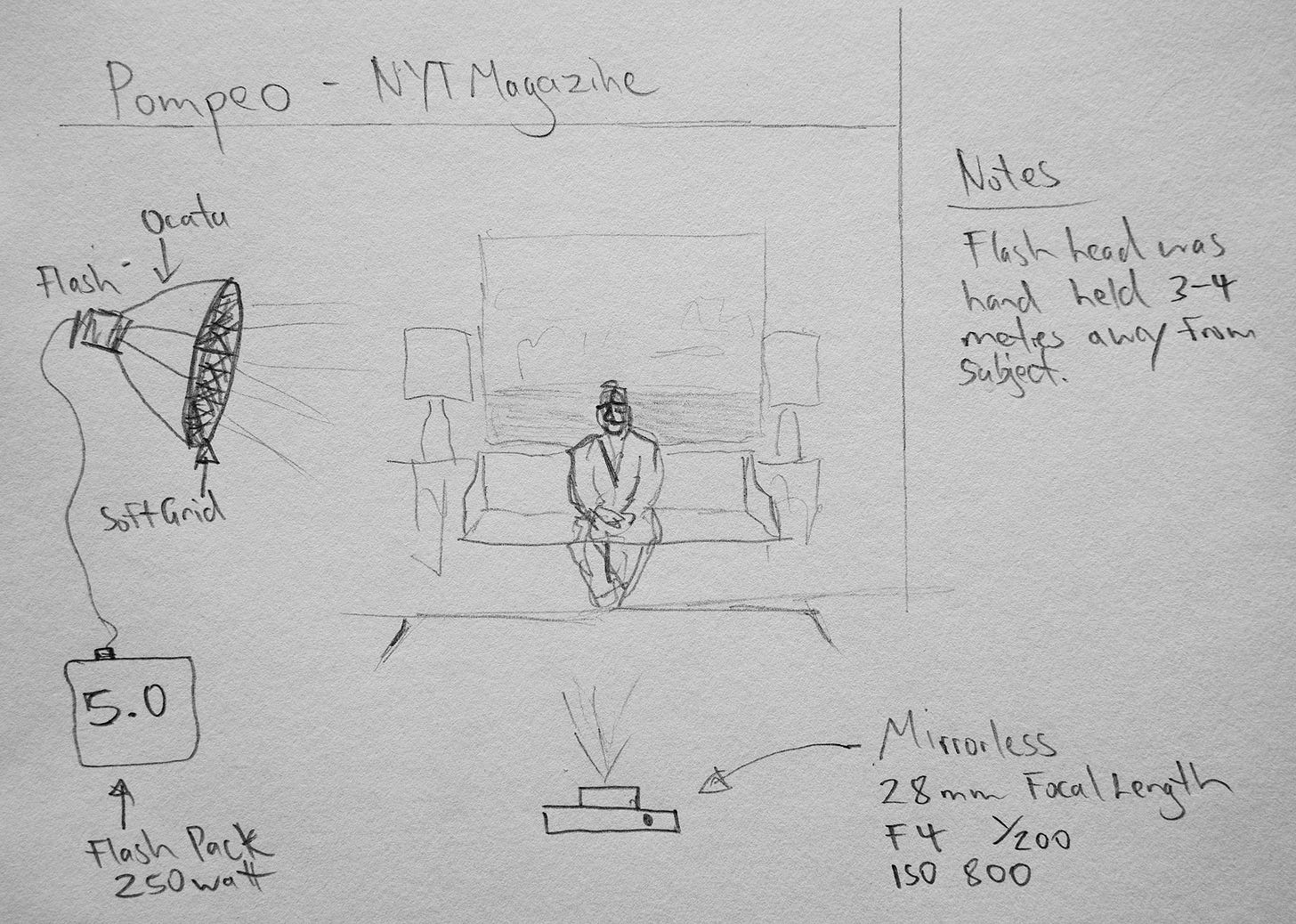A Last-Minute Shoot with Mike Pompeo
When a portrait sitting at the State Department doesn’t go smoothly
In early 2019, the New York Times Magazine called and asked if I was available to photograph then Secretary of State Mike Pompeo—the shoot would happen the day after tomorrow at 9 a.m. That was the only time Pompeo’s people had given. It wasn’t a cover story, but the brief was to make a tight portrait (if it became one) and an environmental portrait that was more likely to be published.
I took the early train from New York to D.C. the next day, and at 7:30 a.m., my assistant and I arrived at the state department hauling three bags of equipment. Pompeo’s people were accommodating, but by the time we cleared security and got to our shooting space, we only had one hour to pre-light. This was not ideal for two set-ups; usually, I would take at least two hours to pre-light for two different photographs. We went for it: background up, flash heads on stands, negative fill on a stand, hair-light. I was nervous as I started test-shooting with my assistant.
Ten minutes before the Secretary of State was scheduled to arrive, Pompeo’s handler walked in and said the shoot was off. I asked if it was pushed to later. “It’s canceled,” he said and walked out.
I looked over at my assistant and smiled, partly disappointed and partly relieved. We were nowhere near ready, and I wasn’t feeling as relaxed as I like to be when directing a subject like Pompeo—someone who would be hard to disarm. I knew we might have to come back again tomorrow, or in a week, or a month, so we took stock of the lighting and started breaking down.
Just after 9 a.m., the handler walked back in. “He’s coming.”
I thought the handler was joking. Surely these guys would find some pleasure in tormenting the New York Times, but he looked at me deadpan, and I knew the shoot was on. The background was still up, and most of the equipment was still out; I shoved the flash heads back onto their stands. Five minutes later, Pompeo walked in and shook my hand. I directed him to a piece of gaffer tape marking his place amidst the lighting equipment. I nervously made eye contact with my assistant, seeking some reassurance our setup was ready.
Pompeo was jovial. When I asked him to look at me with a serious expression he did, but with a smile that made him look smug. I wasn’t happy with what I was getting. After 10 minutes of directing him, I asked him to move into the other room for the environmental portrait. This was the primary photograph the magazine wanted, but because of the abrupt cancellation of the shoot, we hadn’t metered or tested the light. I switched from a DSLR with an 85 mm lens to a mirrorless camera with a wide lens. When I asked Pompeo to sit in the middle of the chair and raised my camera to my eye, I realized the settings on the digital viewfinder were set so they replicated my exposure settings. This meant that at 1/200 at F4, all I could see in the viewfinder were dark, grainy shapes. Blindly, I photographed. And guessing, my assistant set the power pack for the flash at half power, handheld the flash, and aimed. Neither of us knew what we were getting, but I couldn’t stop; there was no time. I wanted to capture the first few moments of him sitting before he started smiling at me again.
Pompeo gave me 25 minutes in total, which for political portraits is a heap of time. The Times ran the environmental portrait, and thankfully they didn’t need the tighter image (below), which I never did like. The chosen photo was from those first seconds when Pompeo sat down. He was looking at his handlers and wasn’t sure if I was ready to shoot. I was fumbling and was unable to see through my viewfinder. In that moment of everything falling apart for me technically, Pompeo had space to relax. And that was the image.
Equipment and Specs
Mirrorless camera
28 mm lens
F 4
1/200 shutter
ISO 800
Flash Head (250 Watt)
Flash pack
2ft Octabox
Soft Grid for Octabox
Flash transmitter/Air remote
The enviromental portrait was made with a mirrorless digital camera and a 28-75mm F2.8 lens zoomed out to 28mm. The shutter was set at 1/200, the aperture F4 and ISO at 800. This exposure was approximately one to two stops under the ambient light exposure of the room, making the room seem darker than it would have if I exposed it for the ambient room light.For the light source, I used a single flash head with a 2ft Octa softbox with a soft grid on it. This gave a small source and the grid allowed the soft source to be focused on the subject without spilling onto other areas of the room.
The flash was held 2-3 meters away from the subject to camera left and at approximately 7ft high. My assistant hand held the flash head and angled it slightly down so the light pointed to the subject's head level. Although the flash was also pointed just in front of the subject. This meant the centre of the flash, the most intense part, missed the subject, lighting them with the spill light, or periphery light. This is a technique I use often, as it gives a softer, more natural quality of light.
Lighting Diagram
You can follow me on Instagram here.
If you have questions about photography you’d like to have me answer, get in touch at mail@adamfergusonstudio.com






So great to read about your honest behind the scenes experiences. All your posts have been really inspiring, thanks so much!
Got goose bumps reading this real life description.. i to assist some day. Merciii